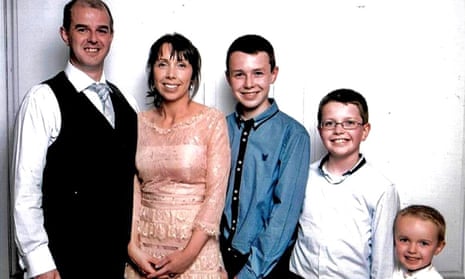Irish media reports of a man who murdered his wife and three children then killed himself have been criticised by women’s rights organisations for portraying the killer as a victim.The groups said Alan Hawe, a school vice-principal who used a knife and a hatchet to kill his family at their home in County Cavan, should be described first and foremost as a murderer who engaged in the most extreme act of domestic violence.
Their bodies were found in the property, near Ballyjamesduff, on Monday morning after a relative raised the alarm.
In the aftermath of the deaths, some Irish news organisations focused on Hawe’s reputation as a pillar of the community, with some reports asking what drove the 41-year-old to kill himself as well as his entire family.
Hawe stabbed his wife, Clodagh, and sons Liam, 13, Niall 11, and Ryan, six, then hanged himself. According to some reports, he left a suicide note saying his family could not cope without him.
Women’s Aid in Ireland, which works with the victims of domestic violence, said people were “rushing in with excuses” over what Hawe did.
Margaret Martin, the group’s director, said: “It is very clear he was a murderer, that is fairly conclusive. Does committing suicide mitigate you killing other people before that act? If he went into a school and killed staff and students before killing himself what would we say? We have to stop the denial here.”
Expressing concern over the way elements of the media had concentrated on Hawe’s career, his sporting prowess and his voluntary work as treasurer at the local Gaelic sports club, Martin said: “In terms of domestic violence, people have stereotypes of the victim and the perpetrator. There is a disconnect between an act like this and someone who is seen as a pillar of community, who is well liked or seen as respectable.
“But our experience dealing with women feeling under threat every day is that it is not just people involved in criminal activity who are capable of this. It does not matter how rich, how educated or how well off they are. Abusers cut across all social classes.”
Martin continued: “The first reaction to something like is denial, an immediate blinkering. Yet what are the facts in this case? There were four people who were killed and then he took his own life. That is the ultimate level of control: to decide who lives or dies. It is the most extreme form of domestic abuse.”
The National Women’s Council of Ireland has said it has received many complaints over the way Hawe was portrayed as a victim.
Orla O’Connor, the organisation’s director, said: “Men who choose to kill their partners should not be portrayed as equal victims. It is not okay to consider the apparent reasons for the murder(s) to be more important than the lives of those murdered.”
Criticism over the portrayal of Hawe was sparked by a feminist blogger who raised questions about media coverage of the case. Her blog and online protests were picked by the media commentator Roy Greenslade.The Hawe family will be buried together after requiem mass at St Mary’s Church, County Cavan, on Saturday afternoon.
